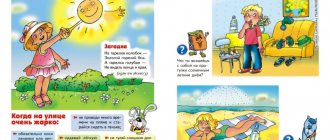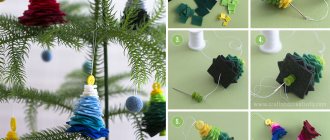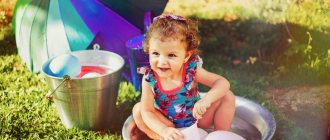Consultations for parents in the summerconsultation
Consultations for parents
in summer
Consultation for parents “What to do with children in the summer?”
Every child looks forward to the coming of summer. At the same time, for parents, summer is another headache in search of an answer to the question “what to do with children in the summer.” Spending the entire three months in front of a computer or TV is not a good idea. This way you can easily lose the knowledge and skills gained over the year. Let's discuss options that will help increase them and spend the summer profitably.
1. Holidays at sea. Many families go south in the summer to take a break from the hustle and bustle and improve their health. However, such a trip does not solve the issue of keeping your child busy in his free time. It is unlikely that he will be delighted with a passive beach holiday or idle time in a hotel. You should make sure that your vacation program includes interesting excursions, entertainment events, etc. The best option would be to choose a hotel that, among other things, offers regular cultural and entertainment programs for children.
3. Rest at the dacha. A country house is not only about detachment from everyday worries in a secluded place alone with blooming nature. This is an opportunity to involve your child in work. You are unlikely to be able to turn your child into a convinced gardener, but in addition to garden beds, you can organize other interesting tasks. This could be the construction of birdhouses, trips to the forest to pick mushrooms or berries, installation of a weather vane, construction of a swimming pool or artificial pond. Show your child that you trust him and hope for his help, and he will strive to carry out your instructions responsibly.
4. City. To limit your child’s time in front of the TV and the computer, give him small household tasks - cleaning the apartment, walking the dog, or taking out the trash. If some subjects at school are difficult for your child, you can improve his knowledge over the summer. To do this, give him daily exercises in the problematic discipline. Your child probably received creative assignments at school for the summer. Your task is to get him to fulfill them diligently, conscientiously and inventively. Also take care of organizing children's reading. Your child should have a reading list for the holidays. In the summer you can also visit museums, exhibitions or performances for which there was sorely not enough time during your child’s studies. Summer is a good time to start classes in some section. The child will not only begin a new stage in his physical development, but will also significantly expand his social circle.
It’s very good if you time your vacation to coincide with your child’s vacation and relax with him. In this case, you will certainly be able to organize your vacation pleasantly and usefully. All children strive to discover something new and do not like boredom. Therefore, you should try to turn the most ordinary activities into exciting and educational games that will make your child stronger, bigger and smarter over the summer.
Consultation for parents
"Games with a child in summer"
Playing with parents is an integral part of children's development. This is both health promotion and good mood. Playing games together brings parents and children closer together. Your child will be delighted when he sees his serious dad happily playing ball. For a preschooler, “play is the only way to free yourself from the role of a child while remaining a child.” For an adult, “the only way to become a child again while remaining an adult.”
When going on vacation with your children out of town, with a group of friends, don’t forget to take with you the necessary attributes for the game, these can be balls, rackets, and much more, which is enough for your imagination.
What can you play with your child that will bring joy to you and your children? Choose games that are accessible to your child. Keep in mind that children will quickly lose interest if they do not experience the joy of victory. Remember the games you played as a child, teach these games to your child. This will bring great pleasure to both him and you; childhood memories are very pleasant! Ask your child to introduce you to the games he plays with his peers in kindergarten. Be an attentive listener, because these are the most valuable minutes of your communication. In addition to a great mood, games help improve family relationships and bring children and parents closer together. We offer you a list of games that you can use with your children during the summer holidays.
Ball games
"Edible - inedible"
This is one of the ancient games. Its rules are quite simple. The players stand in a row, the leader throws the ball to each of the players in turn, while saying a word. If the word is “edible”, the player must catch the ball, if “inedible” - push it away. If a player makes a mistake, he changes places with the leader.
"Name the animal"
You can use different classifications of objects (cities, names, fruits, vegetables, etc.). The players stand in a circle and begin to pass the ball to each other, calling out the word. A player who cannot quickly name a word is eliminated from the game. By playing such a game, you expand your child's horizons and vocabulary.
"Catch the ball"
If you happen to have two balls on vacation, you can play this game. The rules are very simple. Players pass the ball to each other on command, trying to prevent one ball from catching the other.
“Race with the ball” (relay game)
The players are divided into two teams. Each team has a ball. Put the children first on the team. Determine the place to which you need to “jump”. On command, players begin to jump with the ball held between their knees. The team that completes the task faster without dropping the ball wins.
"Dodgeball"
The players are divided into two teams. One team stands in the middle, the other team with the ball stands on both sides. The team with the ball tries to hit the ball and “knock out” the players from the center. Then the teams change places.
This is a very small list of ball games that you can play with your children on vacation. Fantasize, come up with your own games, and you will be in a good mood.
You can also use many other things for cooperative games. If you are relaxing in the forest, look around, you will probably find cones there. Have a competition. “Who will collect the most cones?” Play the game “The most dexterous”. Find a stump and place a plastic bottle on it. Now try to knock it down with a cone from a distance. Use acorns, pebbles, twigs for games, and use your imagination with your children.
Introduce children to Russian folk games: “Burners”, “Leapfrog”. Remember the games you played as a child: “Gardener”, “Paints”, “Grandma, the threads are tangled”, “Blind Man’s Bluff”. Your child will be delighted, and you will be back in childhood. A great mood is guaranteed for both you and your child.
We wish you a good family holiday!
Consultation for parents “The good and evil sun”
Yearning for warmth and light, in the summer we spend too much time in direct sunlight, forgetting about the danger of burns and heat stroke. Even before the heat sets in, you should purchase a children's protective cream that protects the skin from excess ultraviolet radiation.
Sunburn is not as harmless as many people think. It has been proven that they can lead not only to premature aging of the skin and the development of photodermatitis (allergy to sunlight), but also to decreased vision and even cancer (skin cancer).
How to protect your child from sunburn and heat stroke: • When going outside, be sure to wear a Panama hat for your baby.
• If your baby is under 6 months old, you can't use sunscreen, just don't expose your baby to direct sunlight.
• For children over 6 months of age, sunscreen with a protection factor of at least 15 units is required.
• Apply protective cream to exposed skin every hour and every time after swimming, even if the weather is cloudy.
• During the period from 10.00 to 15.00, which is the peak activity of ultraviolet rays A and B, it is better not to sunbathe at all, but to sit in the shade. • Even if the child is not sunburned in the first 5 days, the period of exposure to open sun should not exceed 30 minutes.
• The child should periodically cool down in the shade - under an umbrella, awning or under trees.
• Dress your baby in light cotton clothing.
• Children should drink a lot in hot weather.
• If the child is still burned, wrap him in a towel soaked in cold water, and when he returns home, wipe him with a solution consisting of water and vinegar in a ratio of 50 to 50.
• In summer, the risk of thermal burns also increases. When sitting by the fire or stirring jam in a bowl, be extremely careful if there is a small child next to you.
• If the burn is larger than 2.5 centimeters, it is considered severe and the child requires specialized medical care. Before being taken to a hospital or emergency room, care must be taken to cool the burn site. You cannot open blisters or apply plasters to the burn - it is better to limit yourself to a loose sterile bandage.
Consultation for parents
"Food poisoning"
In the summer, few parents resist the temptation to give their baby fresh milk or treat him with unwashed berries from the garden or vegetables from the garden. Fresh milk is very harmful for young children, because unlike milk that has been heat-treated and sterilely packaged, it can cause not only intestinal disorders, but also infectious diseases.
Berries such as strawberries, raspberries and wild strawberries must be washed especially carefully. Unwashed or poorly washed greens “from your garden” can lead to the development of yersiniosis in a child, also known as “pseudotuberculosis” or “mouse fever”. Even food products that are common for children in the hot season quickly deteriorate and their shelf life is reduced.
It is unacceptable to give your child raw water, even spring water or after purification through a filter.
How to avoid food poisoning: • Wash your hands before and after touching food.
• Hot food should be reheated and served hot. Cook meat and dairy products to at least 70 degrees.
• Perishable foods can be kept not in the refrigerator - at room temperature (about 20 degrees) - no more than 2 hours. If you go on a picnic in the heat, the storage time for food is reduced to 1 hour.
• After contact with raw meat, the dishes must be washed very thoroughly, and it is better to scrub the cutting board with a hard sponge.
• When cooking and heating food in the microwave, stir it periodically or taste food from different places, because... The temperature in the microwave is not distributed evenly enough.
• An overheated car turns into a real germ incubator. Products can be kept in the car no longer than the melting time of the ice cream.
Consultation for parents: “Insect bites”
Summer is a blessed time. Time for relaxation and interesting activities. But in the summer mosquitoes, ticks and bees cause us trouble. And our task is to try to protect our children from insect bites. Nowadays more and more children have allergic reactions and we need to know how to avoid these troubles.
In summer, our biggest concern is mosquitoes.
When they bite, they inject a special substance under the human skin that causes severe itching. Children constantly scratch the mosquito bite area. To reduce itching, you can lubricate with fenistil gel. You can also apply a cool soda compress or ice cube to the bite site. A scratched wound creates fertile ground for other infections. And as a result, the scratched areas become inflamed, become red, painful and may even fester. If the wound is still scratched, you need to treat it with brilliant green or hydrogen peroxide.
To avoid mosquito bites, you need to take some precautions:
Protect your home from mosquitoes. We need to hang mosquito nets on the windows. Periodically treat them with preparations that repel insects.
If mosquitoes have nevertheless entered your home, then you need to use drugs that kill insects.
When leaving the house for a walk, apply insect repellent products to your baby's skin. At the same time, remember to avoid getting drugs into your eyes. If this does occur, immediately rinse your eyes with plenty of running water.
But it's not just mosquitoes that bother us.
Let's talk about ticks.
They are the most dangerous insects, since ticks are carriers of infectious diseases. These viral infections affect the spinal cord and brain. The disease is severe, with high fever, convulsions and can lead to various complications.
What to do if you notice a tick on a child’s body?
Do not try to remove it yourself, but try to go to the emergency room as soon as possible. There the insect will be removed and checked to see if it is a carrier of the infection. If you are far away and cannot see a doctor quickly, remove the tick yourself. You need to remove the insect with tweezers, making twisting movements and trying not to damage the abdomen and proboscis. Remember, you cannot pull quickly, as you can leave the upper half of the tick’s body inside the skin, and this is dangerous due to inflammation and suppuration. After removing the tick, make sure there is no part of it left behind. If everything is clean, wash the bite area with water or alcohol, lubricate it with iodine or brilliant green. Then wash your hands thoroughly with soap, after putting the tick in a bag, and take it to the emergency room as soon as possible. Only there will they determine the degree of danger by checking him for carriage of the pathogen.
What precautions should you take to avoid being bitten by a tick:
Your clothes should be as light-colored as possible, as it is easier to spot insects on them;
Try to cover your skin as much as possible: wear socks, trousers, a long-sleeved shirt, and cover your head with a Panama hat or baseball cap;
Do not allow children to walk barefoot on the grass, sit or lie on the ground without first inspecting the surface of the soil;
Every 15–20 minutes, examine yourself from head to toe;
Do not stay overnight unless you have purchased anti-tick sprays in advance to use on your tent and sleeping bag.
I also wanted to remind you about insects such as bees, wasps, and hornets. The bites of these insects are very painful. The bite site quickly turns red, becomes swollen and swollen. The child complains of severe throbbing pain. Body temperature may rise, and sometimes nausea and headache may occur. In addition to painful sensations, the bites of these insects can cause allergic reactions, including anaphylactic shock.
Necessary:
Calm the baby;
Apply a cold compress to the bite site;
Eliminate the possibility of the child overheating and physical activity;
If there is a sting left in the child’s body, it must be quickly and carefully removed;
Treat the wound with hydrogen peroxide;
Give the baby a desensitizing drug orally;
Apply antiallergic gel to the bite area;
If an allergic reaction develops, which is accompanied by increasing swelling, nausea and even difficulty breathing, you should immediately consult a doctor.
Bee, wasp and hornet stings can be avoided if:
Children will not play among the flowers;
They will clearly know that they cannot wave their arms, chase or try to catch these striped insects;
Do not eat sweets outside that attract insects. Do not visit with children places where stinging insects may accumulate;
Protect your children from insect bites. Remember and practice basic safety precautions. Be healthy!
Do-it-yourself consultation for parents
Take your child on an educational and fun journey into the world of dolls. And you can create a puppet theater with your own hands.
These amazing dolls
Many mothers who have played with glove dolls with their babies will agree: this is truly a miracle for the baby. When creating a home puppet theater, you and your child will try on many roles: you will make puppets, draw scenery, write a script, design the stage, think over the musical accompaniment and, of course, show the performance itself. Just imagine how much creativity, ingenuity, and self-confidence this activity will require from the baby. And also training fine motor skills, developing speech, artistic taste and imagination, learning new and interesting things, the joy of joint activities with loved ones, pride in one’s successes... So, let’s try...
chewed paper
Yes, this is exactly how the phrase papier-mâché is translated from French. And this interesting technique of working with paper will help us not only make original dolls, but will also train the baby’s fine motor skills, giving him the opportunity to feel like a real wizard and creator. We start by making a ball out of plasticine the size of our doll’s head. Now, like real sculptors, based on this ball we will sculpt a face or muzzle with eye sockets, nose, and ears. Let the baby try to do it himself, and you help a little and correct his work. When you have the desired face, use a sharp thin knife to cut the plasticine blank into two parts: “face” and “back of the head.” Now, while you are in the kitchen making paste - glue made from water and flour - the baby is doing an important job: tearing old newspapers into small pieces. After this, we dip each piece in paste and glue our plasticine halves. We glued the layer, dried it, and glued the next one. And so 5-6 layers. After complete drying, carefully remove the plasticine from our papier-mâché. Now we connect the two halves of the head together and glue them with a strip of paper or fabric. The most interesting thing remains - coloring. First, cover the entire doll's head with white gouache or tempera in several layers. After the primer has dried, you can begin painting. To do this, it is better to take tempera rather than gouache - it applies well and does not get dirty at all after drying. The final touch is the hair. They can be made from pieces of fur, woolen threads, laces, felt, and braid. It all depends on what kind of character you want to create. Now we make a hole in the head for the finger and attach it to the glove. The result was a wonderful doll, with its own character and personality, into which so much concentrated snoring and labor of the little puppeteer was invested.
Consultation for parents
“Bathing is an excellent conditioning agent”
You can swim in open water starting from the age of two. The swimming area should be shallow, level, and with a slow current. Before giving your child the opportunity to independently enter the water, you need to make sure that there are no holes, deep mud, snags, or sharp stones in this place. An adult must be in the water with the child. When swimming, you must follow the rules: 1. It is not allowed to swim on an empty stomach and earlier than 1-1.5 hours after eating 2. Children must be active in the water 3. If chills appear, immediately get out of the water 4. You cannot plunge into cool water while hot
About traveling with children: To go or not to go south with a child? - the question arises before parents quite often. What advice can you give about this? If you live in the middle zone and if we are talking about an infant, then it is hardly worth going with him on a long trip. Therefore, the best thing is to take him to the dacha. The same should be done in cases where your daughter or son is not yet three years old. The smaller the child, the harder it is for him to adapt to changes in environment and climate. In these fertile places, in the first days, babies become capricious, they lose their appetite, and digestion and sleep disturbances appear. Adaptation to new climatic conditions in children of the first three years of life sometimes lasts a week, or even two. As soon as the child has time to get used to the new climate, he needs to get ready for the return trip. Such rest for a child is fraught with the development of various diseases. As a result, all costs, worries and troubles can go in vain. The sun is good, but in moderation. In summer, children should spend maximum time outdoors. This also applies to the smallest children – infants. However, if older preschoolers are allowed to sunbathe a little, then direct sunlight can be harmful to children. The biggest danger is overheating of the body, sunburn, sunstroke, since a small child has less perfect thermoregulation and his skin is very delicate. Up to three years, light-air baths can be carried out under a canopy or in the shade of trees. In this case, the principle of gradual exposure of the child’s body must be observed. First, the arms and legs are freed from clothing, and then the rest of the body. Already from the age of 1.5 years, a child can take light-air baths wearing only panties. The duration of the first such bath is 5 minutes, then the time gradually increases to 30-40 minutes. Light-air baths are especially recommended for children with weakened bodies. The best time is from 9 to 12 o'clock, in the south - from 8 to 10 o'clock. It is best to end each light-air bath with a water procedure. After a week-long course of light-air baths, preschool children can begin sunbathing. A child can sunbathe while lying down, or even better while playing and on the move. Sunbathing in combination with light-air baths, as well as water procedures, has an excellent strengthening effect. Children become more resistant to flu-like illnesses than those children who have not sunbathed much. Be careful: heat and sunstroke! Experts do not make much difference between these conditions. And this is understandable. The basis of both heatstroke and sunstroke is overheating of the body. The cause of heat stroke is the difficulty of heat transfer from the surface of the body. This is often associated with prolonged exposure to a hot, humid atmosphere. When sunstroke occurs, blood circulation in the brain is impaired. This usually happens when a child walks in the sun with his head uncovered. The younger the child is, the more sensitive he is to the effects of heat and sunlight. Therefore, overheating of the body in a small child can sometimes already occur while taking light-air baths. With mild sunstroke or heatstroke, the symptoms are mostly the same. These are dizziness, weakness, headache. Children often experience intestinal upset. In severe cases, convulsions, vomiting, and loss of consciousness may occur. In all such situations, you need to urgently call a doctor, and before he arrives, move the child to the shade, wet his head and chest with cold water, put a cold compress on the bridge of his nose, and raise his head. Give the child something to drink and calm him down.
Consultation for parents
"Fire is our friend, fire is our enemy"
In the modern world, no one is immune from social upheavals or natural disasters. Have you ever thought that children's pranks with matches and lighters can lead to a fire? Fire always occurs unexpectedly. It would seem that everything was fine just now, and suddenly a flame appears and suffocating smoke appears. But preventing fires is in our hands. Resolving this problem requires coordinated actions of teachers and parents. Children's attraction to fire and playing with matches is well known, although many children know about the dangers of such games and know how to distinguish between “good” and “evil” fire.
When discussing with your child the possible causes of fires, it is important to introduce him to fire safety measures, develop basic knowledge about the dangerous consequences of fires, and teach him how to handle fire carefully.
What to tell your child
“A long time ago, man learned to make fire and use the power of fire to warm himself, cook food, and make machines work. But at the same time, man also learned the destructive power of fire: people died in the flames, homes, crops, livestock, forests, entire villages and even cities burned.
Think and tell us what could cause a fire (faulty electrical appliances, unextinguished cigarette butts, playing with matches and a lighter, firecrackers, an unplugged iron).
Electrical appliances are assistants in human life, and there are a lot of them in every apartment.
If you know how these devices work, explain or listen to the story.
Electric current runs through wires and makes all electrical appliances work. Electric current is our assistant. If it's not there, we won't be able to watch TV, blow-dry our hair, or listen to music. But electric current can be dangerous and even cause a fire.
Rules for using electrical appliances
— If you smell burning rubber, see a smoking wire, or notice that the socket or plug of the electrical cord is heating up during operation, immediately inform an adult about this and ask them to call a master electrician.
— Don’t forget to unplug electrical appliances. The cause of a fire can be our forgetfulness, inattention, and haste.
You probably know that there are substances that can easily catch fire. These are flammable liquids: gasoline, kerosene, oil. These substances should be kept away from fire as they may ignite instantly. It is impossible to extinguish burning oil, gasoline or kerosene with water; these liquids are lighter than water, so they continue to burn after floating to the surface of the water. What do you think can be used to extinguish them? They are extinguished with sand or a special mixture. People have come up with special devices - fire extinguishers, which are found in every institution, in transport, etc.
Liquids such as varnishes, paints, acetone, alcohol, and liquid oils are also flammable. These substances should be handled with great care. They cannot be stored in the kitchen.
How do you think why? That's right, gas is burning on the stove in the kitchen, matches are often lit here. If they come into contact with flammable liquids, they can cause a fire or even an explosion. Such flammable liquids are stored in special bottles and cans in metal cabinets, away from fire.
Having experienced the power of fire and the great disasters that fire leaves behind, people came up with fire safety rules, the knowledge and observance of which is mandatory for everyone.
Consultation for parents
“On a hot day - on the beach, in the pool, at the dacha”
Water and sand have a magical effect on children. And therefore, the best way to keep your child occupied on a hot day is to go to the beach with him, taking with him a plastic bucket, toys, bedding and cold water. However, on a hot summer day you can do more than just splash in the water and play in the sand. In this chapter you will find tips on how to entertain little ones and what you can suggest to older children who like to play in the water. You will see that a long, hot day will fly by unexpectedly quickly when there is water nearby, and the children are having fun and having fun.
Follow the dealer
In a group of several children playing in a country pool, let each one take turns being in charge. Join their company and join in the fun by giving some helpful tips: the leader can walk like a duckling, flounder like a dog, or float on his back. The rest should imitate him.
Chalk drawings
When you're shopping for the summer season, don't forget about chalk. Let your child and his friends draw with chalk on the asphalt paths in the yard. Give them a bucket of water so they can wash away old designs and make new ones. If several children are playing in the yard, divide the space for drawings into large squares so that each “artist” has his own “asphalt” canvas. Try teaching your kids to play “classroom” or some other outdoor games familiar to you from childhood.
If a child asks: “What should I draw?” - advise him to depict a giant, as tall as possible, a garden, trees, clouds and sky, or a superhighway along which cars, trucks and even trains are racing.
Pleasantly cool
So, today it’s really hot and there’s no hope of finding a body of water nearby. Your child is complaining about the heat - and he's right. Take a bedding and position yourself under a tree. Bring an ice bucket with you.
Let your baby lie on his back and ask him to look at the sky, while at the same time focusing on his sensations. Take an ice cube and, barely touching it, run it along your baby's feet, and then along the inside of the wrists and elbows. If your child likes it, continue applying ice to other parts of the body. How do you think he feels when the ice touches his back or stomach?
Let your baby run a piece of ice over your feet and you will feel the same pleasant coolness that he does.
Looking up to the sky
If it's so hot outside that it's hard to move, it's best not to do it. Sit somewhere in the shade and, lying next to each other, look at the sky, discussing what you see.
Ball in the ditch
At the edge of the water, where the sand is smooth and wet, dig a small groove, after placing two sticks in parallel at a distance of thirty centimeters from each other. Sit at opposite ends of the groove and roll the ball along it towards each other. Try making the channel longer to see how far you can roll the ball. Change its configuration so that the ball can roll faster or overcome obstacles in its path.
Buried Treasure
Designate a small area where the game will take place. One of you hides a clearly visible shell or other small object by burying it shallow in the sand and leveling the area. (No one is supposed to peep.) He then slowly counts down the time while the other player or players poke the sand with a popsicle stick to try to find the hidden item. Children can switch roles, or have an adult bury a few items and have the children look for them all together.
Paintings on the sand
Make sure the surface of the sand is smooth and damp, and let the child draw something on it with a stick or twig. The “artist” is allowed to correct errors only for one minute. You can learn to write letters and numbers.
Game of balls on a fishing line
Dig six holes in the sand so that they form a triangle. Its base, consisting of three holes, should face you. Step a few steps to the side and throw the ball so that it rolls towards the holes. You score three points if the ball hits the top of the triangle, two points if it hits the middle holes, and one point for hitting one of the three holes at the bottom of the triangle.
Pictures for a safety stand: safety corner in kindergarten design
A corner with visual materials on the topic of safety is an integral part of the overall design of each group in kindergarten. By studying useful pictures, instructive stories, tips and rules, young explorers learn to recognize danger both at home and on the street.
Proper design of the safety stand in the future will certainly protect many children from injury, and perhaps even save their lives.
To make it easy to create a stand with information interesting for kids, you can use ready-made pictures and useful materials for filling.
safety rules for children in pictures
Templates for stands and posters about safety for children:
safety pictures for children in kindergarten
Information in the “Your Safety” section of the stand:
summer safety pictures
safety at home and on the streets
promoting safety in preschoolers
about fire safety for children
pictures of rules of behavior for children
what to do if you get lost on the street
Firefighter stand clip art
Posting information about fire safety is one of the ways to inform kindergarten students and their parents. The fire stand in kindergarten is decorated with text and graphic information. Its main task is to convey information in an accessible form on how to prevent a fire, and if one occurs, how to avoid negative consequences.
In a preschool educational institution, the fire stand consists of several sectors, for example, it could be information about fire prevention, types of fire extinguishing agents, propaganda leaflets, evacuation recommendations. For each section it is necessary to select suitable information material in pictures.
In preschool educational institutions, on fire safety stands, it is advisable to place educational pictures on the topic:
- dangerous actions and consequences of a fire;
- actions in drawings during a fire;
- images of fire extinguishing equipment.
Pictures for decorating a stand in kindergarten
where to call fire
fire safety rules in the forest
pictures for children about fire
templates for fire safety stand
folder moving in dow for parents
An interesting part of the fire stand is a sliding folder with information presented in a concise form and with beautiful illustrations. You can fill such a folder with the following materials:
Anime pictures for stands
Preschool educational institutions must have themed corners that help children learn, gain important life skills, simply play, have fun and bring their creative potential to life. To design such corners, educators need visual aids and all kinds of pictures. To make the corner special and unique, you can complement it with anime pictures on different topics.
Leisure in kindergarten and holidays
Traffic regulations, fire safety and health protection
Seasons:
Menu for kindergarten templates pictures
Both parents and children study the menu in kindergarten with interest, because it is interesting to know what the pupils will be treated to today. Each group updates the form with the proposed menu daily, which is placed on the stand. It is especially pleasant to look at the menu, which is beautifully and stylishly designed. To do this, they set up a stationary stand on the wall, and then change the colorful insert templates on which the menu is written every day.
Stand templates with pictures for little ones
Ready-made menu forms for printing





